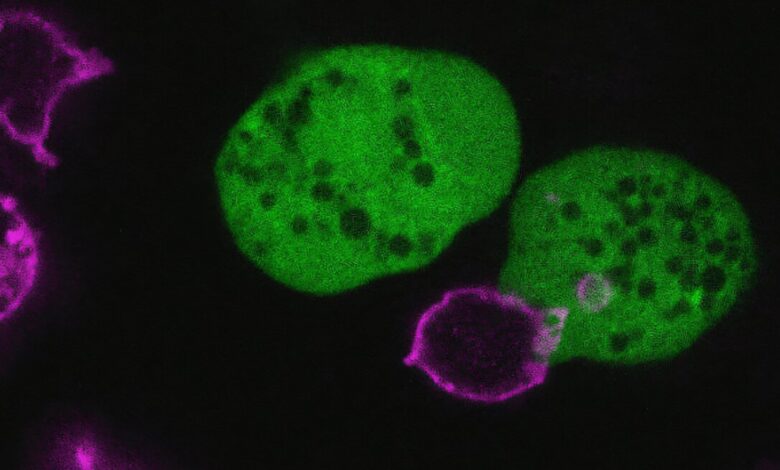This parasite rips apart human cells and wears them as disguises

Microbiologists have finally cracked the code on how the elusive parasite Entamoeba histolytica manages to evade the immune system. This single-celled amoeba is responsible for causing havoc in millions of individuals each year, with fatal consequences for thousands. However, after two decades of research, a team of researchers has uncovered the parasite’s clever strategy and is now working on a plan to combat it.
Entamoeba histolytica is a parasite that typically enters the colon through contaminated water and food. While most cases result in mild symptoms such as diarrhea, a significant number of individuals do not survive the encounter with this parasite. It has the ability to create ulcers in the colon walls and can even destroy parts of the liver, lungs, and brain, leading to fatal outcomes.
Researchers, led by microbiologist Katherine Ralston from the University of California, Davis, have discovered that Entamoeba histolytica has a unique ability to disguise itself from the immune system. By cloaking itself in remnants of dead human cells, the parasite can evade detection and destruction by the body’s immune defenses. This groundbreaking discovery has shed light on the parasite’s enigmatic nature and provided a new avenue for developing targeted therapies.
One of the key findings of the study is that Entamoeba histolytica manipulates human cell proteins to create a shield against the immune system. By incorporating specific proteins from human cell membranes onto its own surface, the parasite can effectively block crucial immune proteins from identifying and attacking it. This macabre disguise has baffled researchers for years, but now, with a better understanding of the parasite’s tactics, they are closer to developing effective treatment strategies.
To combat Entamoeba histolytica, researchers have proposed a novel approach that combines RNA interference (RNAi) technology with CRISPR gene-editing tools. By tagging specific amoeba proteins with fluorescent markers using the RNAi library, researchers can observe how the parasite interacts with these proteins and identify critical targets for intervention. This innovative approach holds promise for developing tailored drugs that can disrupt the parasite’s disguise and halt its destructive path through the body.
With the pieces of the puzzle falling into place, scientists are optimistic about the prospect of developing vaccines and drug regimens to combat Entamoeba histolytica effectively. While challenges remain due to the parasite’s complexity, the research team is confident that their battle plan will lead to significant advancements in the fight against this deadly parasite. As they continue to unravel the mysteries of Entamoeba histolytica, they are paving the way for a future where this tenacious parasite no longer poses a threat to human health. Building upon existing tools and technologies is a crucial step in the process of discovering new treatments and advancements in healthcare. The journey towards finding breakthroughs in medicine often involves a series of incremental steps, with each tool serving as a building block towards the final goal.
In the world of medical research, scientists and healthcare professionals rely on a wide range of tools and technologies to gather data, analyze information, and develop new treatments. From basic laboratory equipment to cutting-edge imaging technologies, each tool plays a vital role in the research process. By combining and refining these tools, researchers can unlock new insights and make significant strides in the field of medicine.
One example of this approach is the use of artificial intelligence (AI) in healthcare. AI algorithms can analyze vast amounts of data and identify patterns that may not be immediately apparent to human researchers. By harnessing the power of AI, scientists can discover new correlations between genetic markers and disease outcomes, leading to the development of personalized treatment plans for patients.
Another example is the use of CRISPR gene editing technology to target and modify specific genes associated with genetic disorders. By building upon the foundational research in genetics and molecular biology, scientists have been able to develop precise tools for editing the human genome, opening up new possibilities for treating previously incurable diseases.
Ultimately, the process of discovery in healthcare is iterative and collaborative. Researchers must constantly build upon the work of others, refining existing tools and techniques to push the boundaries of what is possible. By leveraging the collective knowledge and expertise of the scientific community, we can continue to make groundbreaking discoveries and improve the lives of patients around the world.
In conclusion, the path to new treatments and advancements in healthcare is paved with innovation and collaboration. By building upon existing tools and technologies, researchers can unlock new possibilities and drive progress in the field of medicine. It is through this process of continuous improvement and discovery that we will ultimately find new ways to treat and cure the most challenging diseases of our time.





